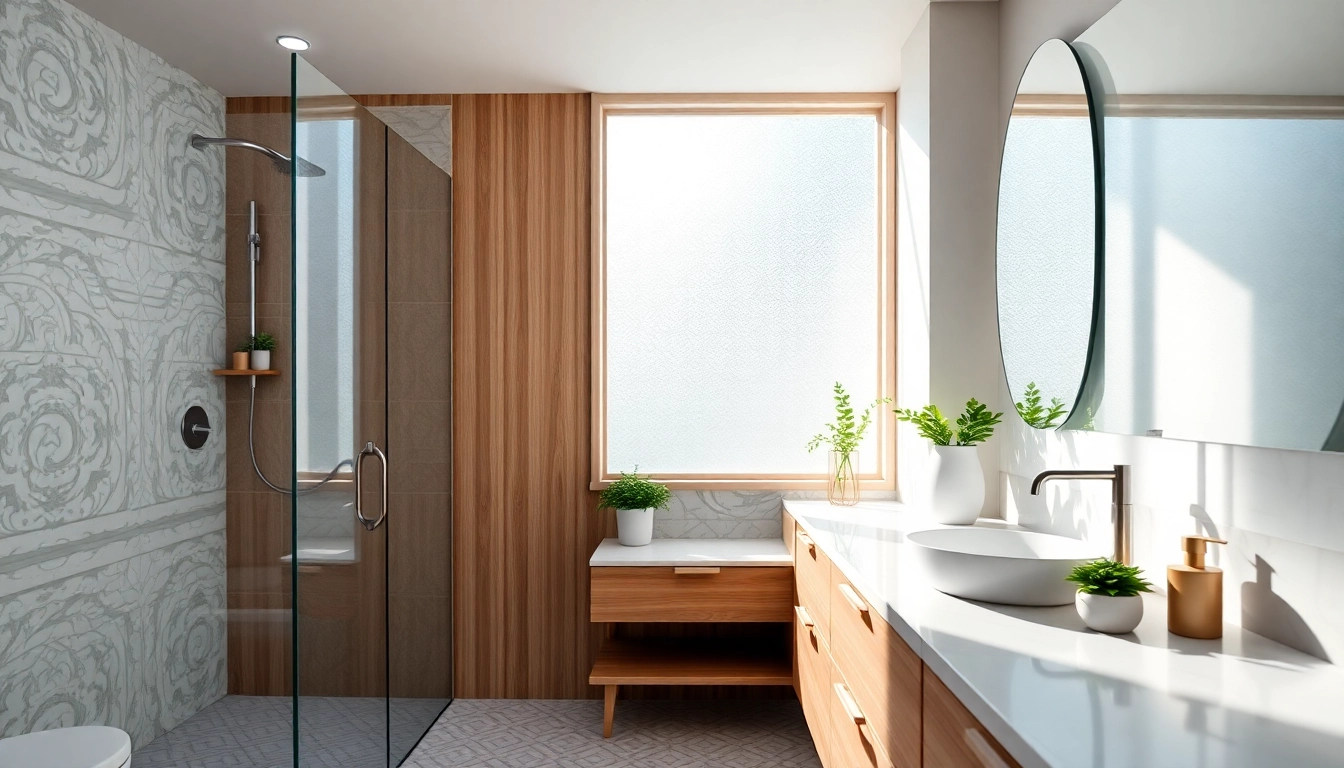Transform Your Space: Ultimate Bathroom Remodeling Contractor Tips for 2024

Understanding the Role of a Bathroom Remodeling Contractor
What Does a Bathroom Remodeling Contractor Do?
A bathroom remodeling contractor specializes in transforming existing bathrooms into updated spaces tailored to the preferences and needs of their clients. This includes overseeing all aspects of the renovation like plumbing, electrical work, tiling, cabinetry, and fixtures. Typically, they manage the entire project from initial planning to completion, ensuring that it adheres to local building codes and regulations. By serving as a project manager, they coordinate different tradespeople and suppliers to harmonize the workflow, oftentimes providing a single point of contact for homeowners.
Benefits of Hiring a Professional Bathroom Remodeling Contractor
Engaging a bathroom remodeling contractor offers several advantages:
- Expertise: Contractors possess the necessary experience and training to foresee challenges and implement effective solutions efficiently.
- Time-Saving: With their established relationships with suppliers and tradespeople, contractors streamline the process, helping projects to be completed faster.
- Quality Assurance: Professionals are more likely to deliver quality work due to their experience and understanding of best practices in the industry.
- Budget Management: A contractor can help you set a realistic budget and keep your project within financial limits, avoiding common pitfalls that lead to overspending.
What to Look for in a Bathroom Remodeling Contractor
When selecting a bathroom remodeling contractor, consider the following actionable criteria:
- Licenses and Insurance: Ensure they have the proper licenses and insurance coverage to protect both parties in case of accidents or mishaps.
- Portfolio: Review their past projects to gauge their style and quality of work with before-and-after photos and customer testimonials.
- Communication Skills: Good communication is essential; look for a contractor who listens to your ideas and provides clear feedback.
- References: Speak to previous customers to get firsthand insights into their experience and satisfaction with the contractor’s workmanship.
Planning Your Bathroom Remodel: Key Considerations
Setting a Realistic Budget for Your Bathroom Renovation
The first step in any remodeling project is to establish a budget. Start by determining how much you are willing to invest in the renovation, bearing in mind that the average bathroom remodel can range significantly.
Here are some pointers for creating a budget:
- Research Costs: Gather data on typical remodeling costs in your area—from labor to materials—to create a comprehensive estimate.
- Factor in Hidden Costs: Prepare for potential extra expenses, including plumbing updates, electrical work, or unforeseen structural issues.
- Prioritize Needs vs. Wants: Distinguish between what you need (a new toilet, better lighting) versus what you want (luxury fixtures), to fine-tune your budget effectively.
Choosing the Right Design and Style for Your Space
Deciding on a design style is vital to the success of your project. Popular styles include:
- Modern: Clean lines, minimalistic design elements, and a focus on functionality.
- Traditional: Warm colors, classic fixtures, and ornate details that provide a timeless look.
- Contemporary: An ever-evolving style often defined by trends, emphasizing innovation and creativity.
Use inspiration from magazines, websites, and professionals to visualize the design that resonates with your personal taste.
Permits and Regulations: What Your Bathroom Remodeling Contractor Needs to Know
Depending on the scope of your project, you might require permits, particularly if you are modifying plumbing or electrical systems. It’s crucial to:
- Consult Local Building Codes: Understand your local regulations to prevent any legal issues during the renovation process.
- Involve Your Contractor: A knowledgeable contractor will be well-versed in these requirements and can help secure necessary permits.
- Consider Inspections: Know that inspections might be required at various project stages to ensure compliance.
Common Challenges in Bathroom Remodeling Projects
Identifying Potential Issues Before the Remodel Starts
No remodeling project is without challenges. Identifying potential issues before work begins can save time and budget surprises:
- Water Damage: Inspect existing plumbing and water sources to prevent future leaks.
- Outdated Electrical Systems: Evaluate if any updates to the electrical system are necessary to accommodate new fixtures.
- Structural Issues: Check for any underlying strengths or weaknesses in your walls or flooring that could affect the remodel.
How to Communicate Effectively with Your Bathroom Remodeling Contractor
Effective communication is essential for a successful renovation. To facilitate smooth dialogue:
- Establish Regular Updates: Schedule consistent check-ins to address any ongoing concerns or changes in the project timeline.
- Clarify Expectations: Be explicit about what you envision and expect from the remodel, including timelines and outcomes.
- Provide Feedback: Throughout the process, give constructive feedback on the progress to ensure alignment with your vision.
Managing Timeline Delays and Budget Overruns
Remodels can often exceed the original budget or timeline due to unexpected issues. Here’s how to manage such scenarios:
- Set Contingency Funds: Allocate an additional 10-20% of your overall budget to account for unforeseen costs.
- Stay Flexible: Recognize that changes may be necessary, and maintaining adaptability can ease stress.
- Communicate Changes: Ensure that any changes to the plan are discussed immediately to avoid misunderstandings.
Best Practices for a Successful Bathroom Remodel
Creating a Functional Bathroom Layout with Your Contractor
The layout of your bathroom is crucial for both aesthetics and functionality. When working with your contractor:
- Consider Traffic Flow: Ensure that door swings and pathways consider basic movements within the space.
- Prioritize Necessities: Placement of essential fixtures such as the toilet, sink, and shower/bathtub should minimize complications.
- Explore Storage Options: Integrate cabinets or shelving where appropriate to enhance organization without overcrowding.
Choosing Quality Materials for Lasting Results
Quality materials are key to longevity and aesthetic appeal in your remodel. Consider the following:
- Durability Over Price: Investing in durable materials will save money on repairs in the long run.
- Moisture-Resistant Options: Choose moisture-resistant materials for areas prone to water exposure, such as tiles or specific paints.
- Eco-Friendly Alternatives: Consider sustainable materials that have a lower environmental impact.
Ensuring Safety and Compliance During the Remodeling Process
Safety during a remodel cannot be overlooked. To promote a safe work environment:
- Follow Safety Protocols: Ensure that all workers comply with health and safety regulations.
- Use Protective Gear: Encourage the use of hard hats, gloves, goggles, and masks as needed by workers to prevent injuries.
- Check for Hazards: Inspect for electrical hazards or unstable materials before work begins.
Measuring Success: Evaluating Your Bathroom Remodel
How to Assess the Work Done by Your Bathroom Remodeling Contractor
After your remodel is complete, it’s essential to evaluate the work done. Assess key areas:
- Visual Appeal: Does the finished bathroom meet your design expectations and aesthetic preferences?
- Functionality: Are all fixtures and features operational, and do they enhance the usability of the space?
- Quality of Workmanship: Are the finishes seamless? Check for any misalignments or poorly installed elements.
Gathering Feedback and Reviews from Your Contractor
Gathering feedback post-renovation is beneficial for both you and the contractor. Consider the following approaches:
- Written Feedback: Leave a formal review detailing your experience to assist future customers.
- Direct Communication: Discuss openly with your contractor about what went well and what could be improved in future projects.
- Follow-Up: Schedule a follow-up appointment after several months to address any emerging issues that might arise after the remodel.
Post-Renovation Maintenance Tips for Longevity
To maintain the integrity and aesthetics of your remodeled bathroom, implement maintenance strategies:
- Regular Cleaning: Use appropriate cleaners for surfaces to avoid buildup and discoloration.
- Inspect for Moisture: Regularly check for leaks or signs of moisture buildup that could lead to mold.
- Routine Maintenance: Schedule periodic inspections of plumbing and electrical fixtures to ensure they are functioning correctly.





